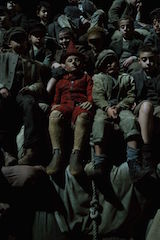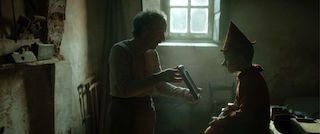 DP Nicolaj Bruel and director Matteo Garrone, who first worked together on the award-winning 2018 feature film Dogman, recently repeated their collaboration on the live action Italian language feature film Pinocchio, starring Oscar winner Roberto Benigni. A live action adaptation of the classic fairy tale about a wooden puppet that is brought to life, the production had to be right on many levels.
DP Nicolaj Bruel and director Matteo Garrone, who first worked together on the award-winning 2018 feature film Dogman, recently repeated their collaboration on the live action Italian language feature film Pinocchio, starring Oscar winner Roberto Benigni. A live action adaptation of the classic fairy tale about a wooden puppet that is brought to life, the production had to be right on many levels.
“Dogman was a relatively small film with a dark, gritty story shot in a handheld, documentary style. I wanted to bring a cinematic look to it as well, to find some beauty within a rough environment,” said Bruel, who used Cooke Anamorphic/i SF lenses on that film.
“It was the first time I had used the Anamorphic/i SF lenses, and they gave me just what I wanted, bringing a touch of charm and creaminess to the darkness, while coping really well with low light and hard light sources. Pinocchio, although very different in story matter, is another relatively dark tale, so we decided to use the Anamorphic/i SFs again.”
“Firstly, the original story is a beloved Italian tale, so it was a big thing for Matteo to take on,” said Bruel. “Secondly we had to strike a balance between the dark aspects of the story and still make it a family movie. Scary enough but not too scary for children, though I think they are far more sophisticated than we often give them credit for, and can understand and enjoy a filmic language of contrast and colors. Darkness itself doesn’t scare them.”
Pinocchio was released in Italy in December 2019, and recently featured in the Berlin International Film Festival 2020.
Bruel’s choice of the Anamorphic/i SF lenses – and the Cooke Look - helped to put heart into the darkness. “The story is set in a very poor environment, and Geppetto carves Pinocchio out of poverty – he wants a son but he also needs to put food on his table. I love the way these lenses portray human skin. I feel they help me take away that sterile feeling you can get with digital capture. I also added a little extra diffusion for an even more romantic look,” he said.
 While Bruel had access to the full set of lenses, his favorites were the 65mm Macro and 40mm lenses. “I loved those lenses,” he said. “Normally you’d go for a longer lens for close ups, but we liked to use the 40mm which gave a very nice intimacy with the actors. It was particularly great on Benigni’s face, and a great treat to be working with him.”
While Bruel had access to the full set of lenses, his favorites were the 65mm Macro and 40mm lenses. “I loved those lenses,” he said. “Normally you’d go for a longer lens for close ups, but we liked to use the 40mm which gave a very nice intimacy with the actors. It was particularly great on Benigni’s face, and a great treat to be working with him.”
The versatility of the lenses, and a simple yet effective lighting design, also helped Bruel to facilitate Garrone’s instinctive way of working. “Matteo likes the freedom to experiment and diverge from the plan if he can see a more interesting set-up or a better approach to a scene,” said Bruel. “We had a fairly simple lighting set-up. For the bigger nights we had 4K balloons on a lift mixed with tungsten 20k’s for a blue and yellow moonlight mix. The interiors were mainly done with small LEDs and Sky Panels so we were able to move those around easily. The Anamorphic/i SF lenses had no trouble with any of the set-ups, they gave great images whether shooting in shadows or strong light sources.”
While much of the VFX work was done in-camera with incredible prosthetic makeup by Mark Coulier and his team, Bruel recorded the Cooke /I technology lens metadata throughout the shoot to supply to London-based VFX house One Of Us for additional CGI work.
 “We have had similar metadata delivered to us with image sequences before, but this was the first time we were fully in control of the workflow from start to finish, and were able to properly integrate the /i Technology data into our pipeline,” said Theo Demiris, VFX supervisor at One Of Us. “It all comes down to re-creating the exact movement and properties of the camera in the digital world, and having access to all of that information meant that we could very quickly ‘solve’ the camera and recreate it with precision.”
“We have had similar metadata delivered to us with image sequences before, but this was the first time we were fully in control of the workflow from start to finish, and were able to properly integrate the /i Technology data into our pipeline,” said Theo Demiris, VFX supervisor at One Of Us. “It all comes down to re-creating the exact movement and properties of the camera in the digital world, and having access to all of that information meant that we could very quickly ‘solve’ the camera and recreate it with precision.”
Demiris and his team found that the most useful lens data elements were focal length, focus distance (which is dynamic and per-frame), lens model and lens serial number.
“The real benefit of having all of that data baked in with the images is that it never lies,” said Demiris. “Any other way is prone to error. You can rely on handwritten data sheets taken on-set but people are often tired and make mistakes and, of course, it takes time. Time to write them down, time to dig them up and log them, time to access them and then use them. Knowing that there is an entire database automatically recorded and easily accessible by all members of the team meant less time organizing and more time making beautiful images.”
Every shot that needed CGi enhancement in addition to the work done by the prosthetics department had to be very precise in order to create a seamless image. A good example of this was the scene in which Pinocchio's nose was growing.
“We had to perfectly track the camera movements as well as Pinocchio's head and torso in order to then replace the nose and parts of the head. The result is a mixture of prosthetics and VFX that is so well integrated that it's very difficult to tell where one ends and the other begins,” said Demiris. “Having experienced this workflow and the level of data available, it's really hard to go back to projects that aren’t set up in the same way.”
Photos by Greta de Lazzaris.
